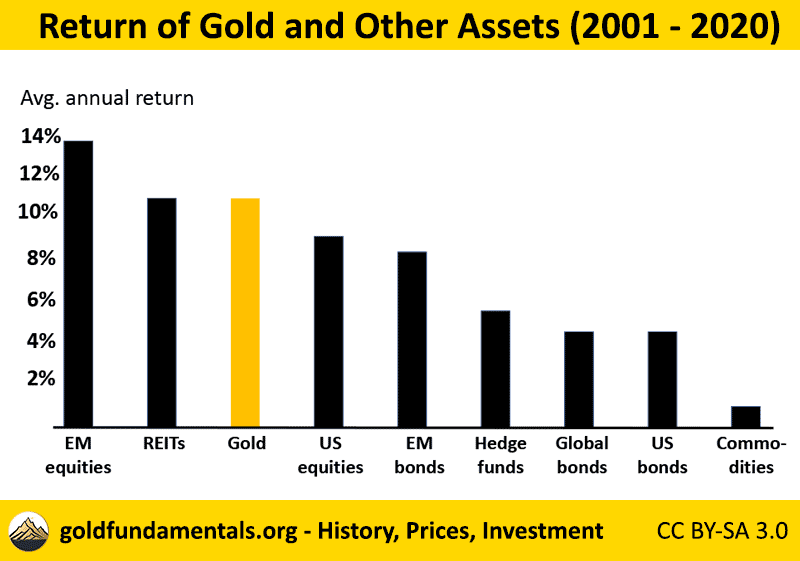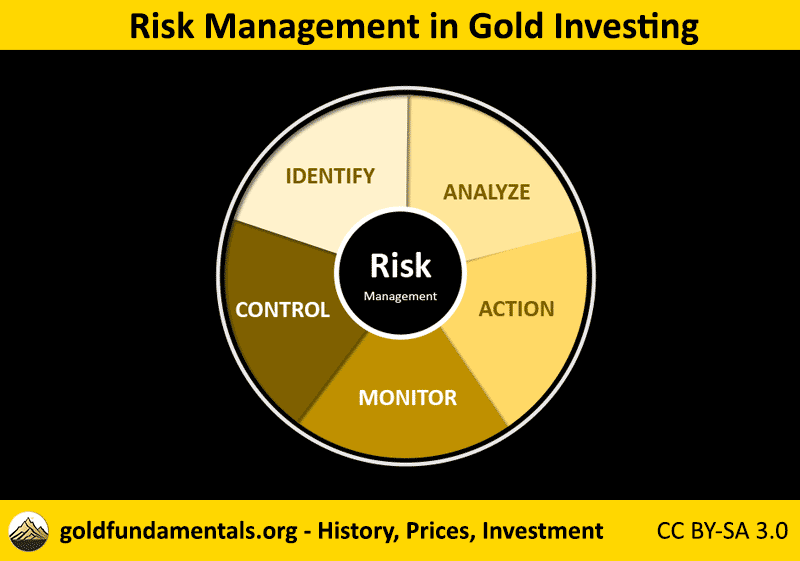This is an extensive overview in 9 parts about gold investing – from the value of gold, types of gold investments and strategies and also: how the gold price is determined, pros and cons of gold investing, risk management and common frauds in gold investing.
Jump right to the article below.
Infographic about gold investing:

Contents
- Introduction
- Part 1: Why is Gold Valuable?
- Part 2: What is the Development of the Gold Price?
- Part 3: What is the Annual Return in Gold Investment?
- Part 4: How is the Gold Price Determined?
- Part 5: What are the Types of Gold Investments?
- Part 6: What are the Pros and Cons of Gold Investing?
- Part 7: What are the Strategies for Gold Investing?
- Part 8: What is the Risk Management in Gold Investing?
- Part 9: What are Common Frauds in Gold Investing?
- Conclusion
- FAQs
Introduction

Welcome to our comprehensive guide on gold investing. Gold has long been recognized as a valuable asset in investment portfolios, known for its stability and potential as a hedge against inflation. This guide is designed to provide you with essential information, whether you’re new to gold investing or looking to refine your strategies.
In this guide, you’ll find:
- Historical and Economic Significance of Gold: Understanding gold’s enduring value and role in the global economy.
- Types of Gold Investments: A look at the different ways to invest in gold, from physical gold coins and bars to gold ETFs and others.
- Pros and Cons of Gold Investing: Insight into the benefits and risks associated with gold as an investment.
- Strategies for Gold Investing: How to approach gold investing, including long-term holding and active trading.
- Risk Management in Gold Investing: Key strategies to manage and mitigate the risks inherent in gold investing.
- Common Frauds in Gold Investing: Awareness of common scams and how to protect your investment.
Check out the short fast paced video about invest in gold:
Whether your goal is to diversify your portfolio, protect against market volatility, or explore gold as an investment option, this guide offers valuable insights. It’s designed to help you make informed decisions in your gold investment journey. Let’s explore the practical aspects of investing in gold and how it can fit into your overall investment strategy.
Check out the table with 10 interesting facts about gold investing:
| Category | Fact |
|---|---|
| Historical Value | Gold has been used as a currency for over 2,500 years. |
| Physical Properties | Gold does not rust, corrode, or tarnish over time. |
| Scarcity | All the gold ever mined would fit into a cube of about 22 meters on each side. |
| Global Demand | India and China are the largest consumers of gold, primarily for jewelry. |
| Investment Popularity | Gold is one of the oldest and most popular ways to store wealth. |
| Market Volatility | Gold prices can be highly volatile; they rose from $272/oz in 2000 to more than $2,000 today. |
| Liquidity | Gold is highly liquid and can be sold quickly in global markets. |
| Gold Reserves | The United States holds the largest gold reserve, with over 8,000 tonnes. |
| Storage Costs | Storing physical gold securely can incur significant costs. |
| Purity Standards | The purity of gold is measured in karats, with 24 karats being pure gold. |
These facts provide a snapshot of the diverse aspects of gold investing.
Let’s start with the question, why gold is valuable.
Part 1: Why is Gold Valuable?

Gold has been a sought-after metal in the Western civilization for millennia. Gold’s value stems from its unique properties, historical significance, and its role in various industries, especially in investment.
Historical and Economic Significance
Gold has been a symbol of wealth and power since ancient times. Civilizations such as the Egyptians (around 3,000 BC) and the Romans (300 AD) used gold for trade and currency (read more about the history of gold). Its rarity is a key factor in its value; according to the World Gold Council, only about 208,874 tonnes of gold have been mined throughout history until 2023. Two-thirds of it since 1950, underscoring its scarcity. Read more about gold mining and production. All gold ever mind would fit in a cube of a length of 22m (73 ft) at each side. See also illustration below.

Economically, gold has demonstrated stability in times of financial turmoil. During the 2008 financial crisis, for instance, gold prices surged from approximately $800 per ounce to over $1,900 by 2011, reflecting its status as a safe-haven asset during economic uncertainty.
Gold’s Proven Reserves
The gold supply is not endless. As said, 208,874 tonnes of gold have been mined throughout history, of this around 139,000 tonnes were dug up since 1950. By current estimates there are only 52,000 tonnes more of proven reserves. But through exploration projects, more gold resources might be uncovered. One thing is clear: gold is finite, more than most other metals, and within the next couple of decades most gold deposits will have been mined.
Check out the video about: how much gold is in the world:
Gold’s Physical Properties and Industrial Use
Gold’s value is also driven by its physical properties: high ductility, conductivity, malleability, and inertness. These properties make it indispensable in various industries (read more about gold properties):
- Jewelry: Due to its malleability and luster, gold is a primary material in jewelry making.
- Electronics: Gold’s excellent conductivity makes it valuable in electronics, used in smartphones and other devices.
- Medicine: Its inertness allows for use in medical applications.
- Aerospace: Gold’s reflective and corrosion-resistant properties are essential in aerospace engineering.
Read more about gold uses.
Gold Demand
Gold Demand falls into 5 categories, which are jewelry, bars and coins, central banks, technology and ETFs. For 2022 the numbers are as follows (source: Gold Council):
| Category | Demand in tonnes |
|---|---|
| Jewelry fabrication | 2,190 |
| Bars and coins | 1,218 |
| Central banks and other inst. | 1,136 |
| Technology | 309 |
| ETFs and similar products | 110 |
Gold in the Modern Investment Landscape
In investment, gold’s importance is increasingly evident. It serves as a hedge against inflation; during the 1970s, when U.S. inflation rates were high, gold prices increased significantly, providing a stable investment option.
Gold is also crucial for portfolio diversification. It typically has an inverse relationship with stock and bond markets, making it a strategic asset during market downturns. For example, when the stock market fell in 2000, gold prices increased, showcasing its value in risk management.
Global economic uncertainties often elevate gold’s investment appeal. The COVID-19 pandemic, for instance, led to a rise in gold investing, with prices reaching over $2,000 per ounce in August 2020. This trend highlights gold’s role as a reliable store of value during crises.
Central banks also play a significant role in the gold market. Institutions like the Federal Reserve and the European Central Bank hold large gold reserves, using them to stabilize and hedge their currencies. The central banks of the following countries have the hightest gold holdings: US, Germany, Italy and France; see table below for the top 10 central banks (as of 2023).
| Rank | Name | Tonnes |
|---|---|---|
| 1 | United States | 8,133.5 |
| 2 | Germany | 3,359.1 |
| 3 | Italy | 2,451.8 |
| 4 | France | 2,436.4 |
| 5 | Russia | 2,298.5 |
| 6 | China | 2,113.4 |
| 7 | Switzerland | 1,040.0 |
| 8 | Japan | 846.0 |
| 9 | India | 806.7 |
| 10 | Netherlands | 612.5 |
In summary, gold’s value is rooted in its historical background, scarcity, unique physical properties and many uses – as jewelry and in the industry. In the financial world, gold is a key asset for hedging against inflation, diversifying portfolios, and providing stability during economic uncertainties. These factors collectively establish gold as a valuable and sought-after commodity.
Part 2: What is the Development of the Gold Price?
Tracing the development of gold prices requires a journey back through centuries. Before the 20th century, gold prices were relatively stable due to the gold standard, where the value of a country’s currency was directly linked to a specific amount of gold. During this period, gold was typically valued at around $20 per ounce in the United States from the late 19th century until 1933.

The shift began in the early 20th century, particularly during the Great Depression. In 1934, the U.S. revalued gold to $35 per ounce as part of the Gold Reserve Act, aimed at stimulating the economy by increasing the money supply.
Fluctuations Throughout the 20th Century and Beyond
The latter half of the 20th century saw more dramatic changes in gold prices. In the 1970s, after the U.S. moved off the gold standard in 1971, gold prices skyrocketed, reaching a peak of $850 per ounce in 1980 due to high inflation, economic instability, and geopolitical tensions.
In the 1980s and 1990s, gold prices experienced a downturn, with prices falling and remaining relatively low, influenced by a stronger U.S. dollar and global economic stability. The price during this period hovered around $250 to $500 per ounce.
The 21st century marked another significant shift. The 2008 financial crisis saw a surge in gold prices from about $800 per ounce to over $1,900 per ounce by 2011, driven by investors seeking a stable investment amidst the economic turmoil.
Recent Trends in Gold Prices
In more recent years, gold prices have continued to be influenced by global events. The onset of the COVID-19 pandemic in 2020 led to another surge in prices, with gold reaching an all-time high of over $2,000 per ounce. This increase was fueled by economic uncertainties and a volatile market environment.
Part 3: What is the Annual Return in Gold Investment?
Average annual return of gold between 1960 and 2023 is 8.1%.
See table below for the annual return of gold in the last 20 years.
| Year | Return in % |
|---|---|
| 2023 | 13.14 |
| 2022 | 2.08 |
| 2021 | -3.73 |
| 2020 | 25.75 |
| 2019 | 18.28 |
| 2018 | -1.06 |
| 2017 | 9.54 |
| 2016 | 8.62 |
| 2015 | -11.61 |
| 2014 | -0.44 |
| 2013 | -27.61 |
| 2012 | 8.69 |
| 2011 | 7.80 |
| 2010 | 30.60 |
| 2009 | 25.04 |
| 2008 | 3.97 |
| 2007 | 31.59 |
| 2006 | 23.92 |
| 2005 | 17.77 |
| 2004 | 4.40 |
Understanding Gold’s Performance Over Time
Gold’s annual return can vary significantly based on various economic conditions and timeframes. Here’s a look at some key periods:
- 1970s: Post the U.S. exit from the gold standard, gold witnessed an unprecedented rise. From 1971 to 1980, gold’s annual return averaged approximately 32.1%. This surge was largely due to high inflation and economic uncertainty.
- 1980s and 1990s: In contrast, gold prices stagnated and even decreased during this period. The average annual return was much lower, often in the negative, due to lower inflation rates and a stronger U.S. dollar.
- 2000s: The early 2000s saw a resurgence in gold prices, with the annual return averaging about 12.8% from 2000 to 2010. This increase was driven by factors like the dot-com bubble burst, the 2008 financial crisis, and a weakening dollar.
- Post-2010: In the years following 2010, gold’s annual return has been more volatile. For instance, in 2020, due to the COVID-19 pandemic, gold prices saw a significant increase, with returns exceeding 20% for the year.
Gold vs. Other Investment Vehicles
Here is an overview of the average return of gold in comparison to other asset classes:

Comparatively, gold’s performance should be evaluated against other investment types:
- Stocks: Over long periods, stocks have often outperformed gold. For example, the S&P 500 has had an average annual return of around 10% before inflation over the last century.
- Bonds: Government bonds typically offer lower returns than stocks but are considered less risky. Gold often outperforms bonds in high-inflation scenarios.
- Real Estate: The comparison with real estate is more complex due to factors like location and property type. However, gold can be more liquid and less management-intensive.
Part 4: How is the Gold Price Determined?

Determining the gold price is a complex process that involves the intricate interplay of the LBMA Gold Price (Gold Fix), spot prices, and futures markets. Each of these elements contributes uniquely to the valuation of gold in the global markets.
The LBMA Gold Fix
A pivotal element in gold pricing is the LBMA (London Bullion Market Association) Gold Fix, established in 1919. This twice-daily electronic auction (formerly a physical meeting) sets benchmark prices used globally by producers, consumers, and investors. The LBMA Gold Fix provides a transparent and reliable reference price for many gold products, reflecting a balance of market supply and demand at the time of the auction. Read more here.
Currently there are 14 participants in the LBMA Gold Fix: Bank of China, the Bank of Communications, Coins ‘N Things, the Industrial and Commercial Bank of China, INTL FCStone, Jane Street Global Trading, HSBC Bank USA, JPMorgan Chase, Koch Supply and Trading, Marex Financial, Morgan Stanley, Standard Chartered, the Bank of Nova Scotia, and the Toronto-Dominion Bank.
Check out the video about the LBM Gold Fix:
The Role of Global Markets
- Spot Market: This market dictates the immediate price of gold, known as the spot price, which is driven by current supply and demand among traders, including central banks, bullion dealers, and investment funds.
- Futures Market: Here, gold is traded for future delivery. The futures price can vary from the spot price, reflecting expectations about future supply and demand, inflation, and currency values.
Influential Factors in Gold Pricing
Several factors significantly impact gold prices:
- Supply and Demand: Market forces of supply and demand are primary determinants. Fluctuations in mining output or increased demand, especially in markets like India and China, can affect prices.
- Inflation: Gold is often seen as a hedge against inflation. Rising inflation typically leads to higher gold prices as the value of fiat currencies decreases.
- Currency Strength: Gold prices are inversely related to the strength of the U.S. dollar; a weaker dollar usually means higher gold prices.
- Interest Rates: Lower interest rates can increase the appeal of gold, as they reduce the opportunity cost of holding non-yielding assets.
- Geopolitical Events: Gold is a favored asset during political or economic uncertainties, leading to higher demand and prices in such periods.
Central Bank Policies
The policies of central banks, including their gold reserves management, are crucial in influencing the gold market. Changes in central bank gold holdings can signal broader economic trends, affecting market perceptions and gold pricing.
Check out the video about what affects the gold price:
Part 5: What are the Types of Gold Investments?
The illustration shows the most common types of gold investment: physical gold, securities, derivatives and alternative gold investments.

Exploring the varied avenues of gold investment unveils a range of choices, each with distinct features, benefits, and risks.
Physical Gold: Bullion, Coins, Jewelry, and Numismatic Coins

Physical gold remains a cornerstone of gold investment:
- Gold Bullion: Commonly available in bars or ingots, with standard weights ranging from 1 gram to 400 ounces. The 400-ounce gold bar, often used by central banks, is worth about $700,000 based on a gold price of $1,750 per ounce.
- Gold Coins: Bullion coins, like the American Gold Eagle and Canadian Maple Leaf, contain one ounce of gold, or other weights, valued at market gold prices. They are recognized by gold dealers and investors all over the world. Other popular gold coins are the Britannica from the UK, the Philharmonic gold coin from Austria, South African Krugerrand and the US Buffalo.
- Gold Jewelry: Globally, gold jewelry accounts for approximately 50% of gold demand. In markets like India, it’s not only a fashion accessory but also a key investment, especially during wedding seasons.
- Numismatic Gold Coins: These collector’s items can fetch prices significantly above their gold content value, with their worth influenced by rarity, condition, and historical factors. They are not suitable for gold investment.

Gold Securities: ETFs, Mining Stocks, and Mutual Funds
Gold securities offer a blend of gold exposure and traditional investing:
- Gold ETFs (Exchange-Traded Funds): Funds like the SPDR Gold Shares ETF are significant players in the market, holding over 1,000 tonnes of gold, which is equivalent to about $56 billion in value.
- Gold Mining Stocks: Shares of companies like Barrick Gold or Newmont Corporation provide exposure to the gold mining industry. The performance of these stocks depends on individual company factors and overall industry health.
- Gold Mutual Funds: These funds, such as the VanEck International Investors Gold Fund, invest in a diversified mix of gold-related assets, offering investors exposure to the broader gold market.
Derivatives: Futures and Options
Gold derivatives are sophisticated instruments for seasoned investors:
- Gold Futures: Contracts traded on exchanges like the COMEX involve agreements to buy or sell gold at a future date at a set price. The daily trading volume of gold futures on COMEX can exceed 200,000 contracts, representing about 20 million ounces of gold. Gold Futures contracts at the COMEX have a size of 100 ounces (with a gold price of USD 2,000 per ounce, this is USD 200,000, which is too much for a retail investor). There are also Micro Gold Futures with the size of 1/10 of future contracts (see more at cme).
- Gold Options: These instruments provide a strategic choice for hedging or speculation. The options market allows investors to manage risk or capitalize on price movements without the full commitment of a futures contract. Similar to futures, options also have a contract size of 100 ounces.
- Gold CFD: A contract for difference is a contract between investor and broker. Instead of buying or selling the gold itself, the investor buys or sells a number of units of the gold CFD. Key characteristics: no physical ownership and the use of leverage possible. CFDs are popular for hedging against portfolio risks.
Alternative Gold Investments: Digital Gold and Gold Certificates
Technological advancements have introduced novel gold investment methods:
- Digital Gold: or digital gold currency (DGC) is an electronic form of money backed by gold reserves held in vaults by private agencies. It is a representative form of money, directly representing gold metal on deposit or in custody.
Historically, countries also issued gold certificates. Most famously in the United States form 1865 till 1933 after which the private ownership of gold was outlawed. Gold certificates looked similar to US dollar bills, were also denominated in US dollar and also authorized as legal tender. Today they only have collector’s value. The following image shows a $20 gold certificate:

Part 6: What are the Pros and Cons of Gold Investing?

Pros of Gold Investing
- Hedge Against Inflation: Historically, gold prices have risen when the cost of living increases. During the 1970s, when inflation skyrocketed, gold prices increased by an average of 15% per year.
- Diversification: Gold often has a negative correlation with stocks and bonds. During the 2008 financial crisis, while the stock market lost over 50% of its value, gold prices increased by 25%.
- Safe-Haven Asset: In times of economic uncertainty or geopolitical tension, gold has proven to be a reliable safe haven. For instance, during the COVID-19 pandemic, gold prices soared to record highs, reaching over $2,000 per ounce.
- Liquidity: Gold is highly liquid. You can buy or sell gold assets quickly in the global market, making it an attractive option for many investors.
Cons of Gold Investing
- No Yield: Unlike stocks or bonds, gold does not pay dividends or interest, which can be a drawback for income-seeking investors.
- Storage and Insurance Costs: Physical gold requires secure storage and insurance, which can add to the investment cost. For instance, professional storage fees can range from 0.5% to 1% of the gold’s value per year.
- Price Volatility: Gold prices can be highly volatile. For example, after reaching its peak in 2011, gold prices dropped by nearly 28% in 2013.
- Impact of Currency Strength: Gold prices are often inversely related to the U.S. dollar strength. A stronger dollar can lead to lower gold prices, affecting the investment’s value.
Check out the video about advantages and disadvantages of gold investment:
Analysis of Pros and Cons of Individual Types of Gold Investments
Each type of gold investment carries unique benefits and drawbacks:
- Physical forms of gold (bullion, coins, jewelry) offer tangibility but come with costs and risks related to storage and insurance.
- Financial gold instruments (ETFs, stocks, funds) provide easier trading and diversification but may include fees and lack the tangibility of physical gold.
- Derivatives (futures, options) offer leverage and flexibility but are complex and entail higher risks.
- Digital gold and certificates offer convenience and ease of transaction but depend heavily on digital platforms or issuers’ credibility.
Here’s a breakdown of each gold investment type presented in a table format:
| Gold Type | Advantage | Disadvantage |
|---|---|---|
| Gold Bullion (Bars) | Tangible asset, pure form of investment, easy to understand | Requires storage and insurance, no yield, a bit less recognizable than coins |
| Gold Coins | Same as bars, additionally: more standardized and recognizable than bars | Same as bars |
| Gold Jewelry | Dual function (adornment and investment), cultural value | Craftsmanship costs (in some countries two times the gold value), lower gold content compared to bullion, more difficult to assay |
| Numismatic Gold Coins | Potential for high collector value, historical significance | always more expensive than its gold value |
| Gold ETFs | Easy to trade, no need for physical storage | Management fees, indirect ownership of gold |
| Gold Mining Stocks | Potential for high returns, dividends from companies | Subject to company-specific risks, market volatility |
| Gold Mutual Funds | Diversification, professionally managed | Management fees, diluted exposure to gold prices |
| Gold Futures | High leverage, no storage required, | Complex, high risk, requires expertise in market, only for seasoned investors |
| Gold Options | Flexibility, less risk compared to futures | Same as futures |
| Digital Gold | Convenient, easy to buy and sell | Reliant on platform security, less tangible |
Considerations for Gold Investors
When considering gold investment, it’s essential to evaluate these pros and cons in the context of your overall investment strategy and risk tolerance. Gold can play a key role in portfolio diversification and protection against economic downturns, but it requires careful consideration of its non-yield nature and potential costs.
Part 7: What are the Strategies for Gold Investing?

Implementing successful gold investing strategies involves a nuanced understanding of market dynamics, historical performance, and risk tolerance. Here’s an expanded view emphasizing detailed facts and figures.
Diversification Strategy
- Balanced Portfolio: Incorporating gold into a diversified portfolio can provide a counterbalance to equities and bonds. For example, during the 2008 financial crisis, while the S&P 500 Index plummeted nearly 40%, gold prices saw an increase of approximately 5%.
- Percentage Allocation: Financial gurus like Ray Dalio, founder of the largest hedge fund, Bridgewater Associates, advocate for a 5-10% gold allocation in a diversified investment portfolio. This strategy is designed to protect against inflation and market downturns, considering gold’s historical performance as a stable asset.
Watch Ray Dalio talking about diversification:
Long-Term vs Short-Term Investing
- Long-Term Holding: Over a period of 50 years, gold has returned an average of about 10% annually. This reflects its status as a reliable long-term store of value, especially during periods of inflation or currency devaluation.
- Short-Term Trading: Platforms like SPDR Gold Shares (GLD) allow investors to capitalize on short-term fluctuations in gold prices. However, this strategy requires a keen understanding of market trends and the ability to respond quickly to changes.
Active vs Passive Investment Approaches
- Active Investing: Involves actively managing gold-related assets like gold mining stocks. For instance, investors might choose stocks of companies like Newmont Corporation or Barrick Gold Corporation, based on their performance, mining efficiency, and market conditions.
- Passive Investing: A passive approach might include investing in gold index funds or ETFs, such as the iShares Gold Trust (IAU), and holding these investments over a longer period. This approach benefits from gold’s overall market performance without the need for active management.
Timing the Market
- Market Analysis: Effective timing strategies often involve analyzing macroeconomic indicators, like changes in Federal Reserve policies or global geopolitical events, to anticipate gold price movements. For instance, savvy investors might increase their gold holdings in anticipation of recessions or global crises.
- Dollar-Cost Averaging: This strategy involves consistently investing a fixed dollar amount in gold. For example, investing $500 monthly in a gold ETF can help smooth out the price volatility over time.
Risk Assessment and Management
- Understanding Risks: Each type of gold investment carries distinct risks. For example, gold mining stocks are subject to operational risks and market sentiment, while physical gold involves storage and insurance concerns.
- Risk Mitigation: A mix of different gold investment types, such as combining physical gold, ETFs, and stocks, can offer a balanced approach. Regular portfolio reviews and rebalancing based on market conditions and personal investment goals are crucial.
Part 8: What is the Risk Management in Gold Investing?
Risk management in gold investing, as in any kind of investing, involves five parts: identify, analyze, action, monitor and control, see illustration below.

Key Risks in Gold Investing
- Price Volatility: Gold’s price can fluctuate dramatically. For instance, after peaking at over $1,900 per ounce in September 2011, gold experienced a sharp decline, dropping to around $1,100 per ounce by late 2015. In 2023 it was back at $2,000.
- Market Liquidity Risk: While gold is typically a liquid asset, its liquidity can fluctuate. In the 2008 financial crisis, gold liquidity briefly tightened, affecting the ease of buying and selling.
- Currency Risk: Gold is usually priced in U.S. dollars, posing a risk for non-USD investors. A strong dollar can decrease gold’s value in other currencies, impacting returns.
- Purity and Authenticity Risks: Investing in physical gold involves risks of impurity or counterfeit products. Ensuring gold’s authenticity, for instance, through certified dealers like the London Bullion Market Association (LBMA), is essential.
- Market Risk: Economic policy shifts and global events can significantly influence gold prices. The 2020 pandemic-induced rally, where gold prices soared to over $2,000 per ounce, exemplifies this.
- Storage risks: Keeping physical gold at home, poses considerable risk in case of a burglary.
- Storage and Insurance Costs: Secure storage and insurance for physical gold can be costly. Storage fees can range from 0.5% to 1.5% of the gold’s value annually, depending on the provider and location.
Strategies for Risk Mitigation
- Diversification within Gold Assets: Investing across different gold forms (bullion, coins, ETFs like SPDR Gold Shares (GLD), and mining stocks such as Barrick Gold Corporation) helps spread risk.
- Balanced Asset Allocation: Financial experts like Ray Dalio recommend a gold allocation of not more than 5% in a diversified investment portfolio to counterbalance volatility.
- Regular Monitoring and Rebalancing: Keeping track of market trends and economic factors that affect gold prices, and adjusting holdings when necessary, is critical.
- Hedging Techniques: Using financial instruments like futures and options, available on exchanges like COMEX, can be effective for hedging against price movements in gold investments. This is only advisable for seasoned investors only.
- Long-Term Perspective: Acknowledging that gold has historically been an effective hedge against inflation can inform a long-term investment strategy.
- Secure Storage Solutions: For physical gold, opting for reputable storage options like Brink’s Global Services or JPMorgan Chase Bank’s vault services can mitigate risks of theft or loss.
Check out the video about storing gold:
Part 9: What are Common Frauds in Gold Investing?

Understanding common frauds in gold investing is crucial for investors seeking to safeguard their assets. Knowledge of these scams, backed by factual instances, can help in identifying and avoiding potential frauds.
Types of Gold Investment Frauds
- Fake Gold Products: Counterfeit gold bars or coins are a prevalent scam. In one instance, a series of gold bars filled with tungsten, a metal with similar density to gold, were found in Manhattan’s Diamond District in 2012. These bars were sold as pure gold, deceiving investors.
- Gold Ponzi Schemes: These schemes promise high returns from gold investments but use new investors’ money to pay returns to earlier investors. The 2009 case of Texas financier Allen Stanford involved a $300 million scheme, significantly impacting gold investors.
- Fraudulent Gold Mining Stocks: Companies may falsely claim lucrative mining prospects to inflate stock values. The Bre-X Minerals scandal in 1997 is a notorious example, where the company falsified claims of a massive gold discovery in Indonesia, leading to a temporary stock value increase before the fraud was exposed.
- High-Pressure Sales Tactics: Overpriced gold coins or inflated investment plans are often sold through aggressive tactics. Scammers use urgency and fear of missing out to push these sales.
- Storage Scams: There have been instances where firms offer to store gold for investors, charging for storage and security, but either never purchase the gold or misappropriate it. This was seen in a case where a firm charged clients for storing gold that was never actually bought, resulting in millions of dollars in losses.
Avoiding Gold Investment Scams
- Verify Authenticity: It’s crucial to verify the authenticity of gold products. Investors should check for weight, size, and hallmark certifications, preferably through accredited dealers.
- Research Gold Stocks and Companies: Thorough due diligence is essential when investing in gold stocks. Investors should review financial statements, track records, and the legitimacy of claimed mining operations.
- Beware of Unrealistic Promises: Any investment claiming guaranteed returns or minimal risk should be approached with skepticism. Legitimate gold investments will not make such claims.
- Avoid High-Pressure Sales: High-pressure sales, especially those pushing overpriced coins or urgent investment opportunities, should be avoided. These are often indicative of scamming tactics.
- Be Wary of Storage Offers: When considering storage services, opt for reputable and transparent providers. Confirm the existence and security of the storage facilities, and be skeptical of companies that lack clear storage documentation or audit trails.
Conclusion

In this guide, we’ve delved into the multifaceted world of gold investing. Our exploration has spanned various dimensions:
- Historical and Economic Significance: Understanding gold’s enduring value and its role in global finance.
- Diverse Investment Options: From physical gold like bullion and coins to gold ETFs and mining stocks, offering a range of choices for investors.
- Pros and Cons: Highlighting the benefits and risks associated with gold investments, including its status as an inflation hedge and the challenges of price volatility.
- Investment Strategies: Outlining approaches like diversification, long-term holding, and active trading, tailored to different investor needs.
- Risk Management: Discussing strategies to mitigate risks in gold investing, ensuring a balanced and informed approach.
- Awareness of Frauds: Emphasizing the need to be vigilant against common scams in gold investing.
Gold continues to be a key asset in investment portfolios, offering stability and value.
FAQs
Is Gold a Good Investment?
Gold is often considered a reliable investment, particularly as a hedge against inflation and during economic downturns.
Are Gold Coins a Good Investment?
Gold coins, especially sovereign mint bullion coins like American Eagles and Canadian Maple Leafs, are a popular choice due to their recognized value and liquidity.
Is Gold ETF a Good Investment?
Gold ETFs can be a convenient way to invest in gold without the need for physical storage, offering flexibility and ease of trading.
Gold Investment vs Silver: Which is Better?
The choice between gold and silver depends on individual investment goals and market conditions. Gold is typically seen as a more stable investment.
What’s the Best Gold Investment for Beginners?
For beginners, well-established bullion coins such as Sovereigns and Britannias are recommended due to their lower premiums and ease of selling.
How Does Gold Investment Work?
Gold investment involves buying gold in various forms (bars, coins, ETFs) with the expectation that its value will increase over time.
Gold Investment vs Bitcoin: Which is Safer?
Gold is generally considered safer and more stable compared to Bitcoin, which is known for its high volatility. Apart from that, we can track the development of the gold price for several thousand years. Bitcoin was only created in 2009. And for bitcoin trading the internet and a sophisticated infrastructure is needed. On the other hand, gold can be literally carried in one’s pocket.
Best Gold Investment in the UK?
Sovereigns and Britannia coins are often recommended for UK investors due to their legal tender status and exemption from Capital Gains Tax.
Where to Buy Gold for Investment?
Gold can be purchased from reputable dealers online or physically. It’s important to research and compare prices, fees, and buy-back policies.
Gold Investment vs Stocks: Which is Better?
Gold and stocks serve different purposes in a portfolio. Gold is seen as a safe haven and a hedge against inflation, while stocks are typically chosen for growth and income.
